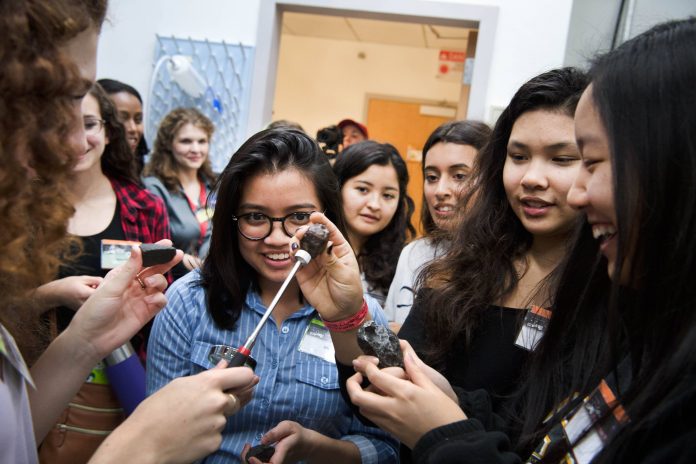Here, Ten industry experts share their advice with Open Access Government, as to how and why businesses and educational institutes can help close the STEM skills gap
Despite the progress being made towards encouraging more women and girls to enter into a career in science, technology, engineering or maths (STEM), there still remains a gender gap. This is why International Day of Women and Girls in Science was first initiated – to encourage young girls into choosing STEM subjects at school, which could lead them into an exciting job in STEM in the future – but what can schools and businesses do to help close to STEM skills gap?
Success STEMs from education
It goes without saying that education starts at school, which is why it is so important for schools across the country to encourage girls into choosing STEM subjects in the classroom. Graham Jackson, CEO at Fluent Commerce believes that equality in employment is an important issue that should be at the forefront of business objectives across all industries. “However,” he comments, “there is no denying that the biggest gap by far is women in technical roles. Educating and encouraging girls to excel in these subjects starts at primary school and hopefully in doing so, will lead to an increase in the rate of women opting to continue the study of these subjects into further education and consider a career in STEM.”
This is something that April Taylor, Vice President at ConnectWise Manage agrees with, suggesting that schools should help in encouraging more girls to become passionate about learning science and technology: “Having the opportunity to build websites, learn to code or use robotic toys can lead them to develop skills and potential careers within the tech sector to become the next developer, security expert or CTO. With the constant developments in technology, organisations need to consider supporting these types of educational initiatives to help build their IT teams for tomorrow.”
One way to go about this is by making STEM ‘fun’, believes Liz Matthews, Head of Community and Education at Mango Solutions. Matthews expands on this by saying: “Encouraging younger girls to choose STEM subjects even if they are considered ‘boring’, shine a light on the career opportunities available to those with STEM qualifications, increase investment in training for women to fill the corporate need, and have the overall goal of closing the STEM skills gap once and for all. For example, one fantastic movement that is doing just this is the Girls in Data initiative, which will be launched by Women in Data this Spring.”
“It makes good sense to strive for a balanced classroom that fosters gender equality, particularly in STEM subjects,” comments Krishna Subramanian, COO at Komprise. “If you think about it, half of our population is female, and more than half of college and university students are female – so why are there so few girls being encouraged into choosing STEM subjects? Businesses are becoming less competitive by not having a good gender balance. They are essentially missing out on an essential division of talent that can contribute to a more innovative future.”
This is echoed in Paula Jory, EMEA Messaging Supervisor at Commvault’s own experience of working in a STEM role. “I have worked in IT support for 22 years and have always been the minority as a woman,” Jory says. “Although this is slowly changing, I believe gender categorisation often starts at home and in early school education. If we can tackle this early, we can achieve a better gender balance in the workplace.”
Supporting women in STEM careers
Achieving an equal gender balance in the workplace is, indeed, the ultimate goal. “Education, particularly in STEM, is the key to addressing many of society’s greatest challenges,” believes Connie Stack, Chief Strategy Officer at Digital Guardian. “Recent research from Microsoft and KRC Research found that confidence in STEM wanes as children get older – especially in girls – but interest can be recovered when subjects are related to real-world people and problems. At Digital Guardian we’re trying to do just that by sponsoring the United Way STEM program, including hosting girls and boys for a cyber security training camp every summer.”
Moreover, the changing technology landscape will interest more women in the STEM sector suggests Hugh Scantlebury, co-founder and CEO at Aqilla. “As technology develops to become increasingly intuitive, or even automated, job descriptions will change and users will be free to focus more on solving business challenges, rather than spending the days crunching numbers, for example.
“I think it is this that will provide the catalyst for the sea change we’ve been waiting for with the number of women working in finance and technology. Intelligent, cloud-based accounting platforms are one example of technology that is enabling users to focus their time on adding value to the business, rather than ‘boring’ number crunching. Surely this has got to attract more people to the sector, both male and female, regardless of whether they are qualified in traditional STEM subjects or not.”
Additionally, organisations themselves need to play their part in promoting women in STEM, according to Sheri Villers, VP of Product Engineering at SentryOne. She says: “Increasing the diversity of our workforce creates diversity of thoughts, strengths and skills which makes companies stronger, more agile and more resilient. Right now, there are simply not enough women taking jobs in STEM industries in particular. There are many facets to this problem, but one important area businesses can get involved with is encouraging girls and young women to study STEM subjects. By developing knowledge and confidence in the areas of science, technology, engineering, and/or math from a young age, more girls will grow up with a passion for these subjects – leading to more women who will embrace jobs in these industries.”
Agata Nowakowska, Area Vice President at Skillsoft, agrees with VIllers, and highlights the underlying issue: “Women are still largely under-represented in the STEM arena and even less so in STEM leadership positions. The reality is that – even in 2020 – it’s so much more difficult for women to climb the career ladder. With persistent unconscious bias that women lack the confidence to apply for promotions or that they are simply not good enough to hold leadership positions, women have to work much harder than men to prove their ability.”
Having this diversity in the workplace is incredibly important, as Bethany Allee, EVP Marketing at Cybera explains. “In the technology industry alone,” Allee comments, “it has proven to result in better business decisions, increased efficiency, and better results. I don’t think it’s a coincidence that the most successful companies tend to be the most progressive in terms of advocating for diversity in leadership roles. That type of success tends to permeate one company’s culture and positively influence an entire downstream ecosystem of other companies.”
To conclude, Nicole Sahin, CEO and Founder of Globalization Partners believes it all comes back to girls having good role models to follow. “Girls should feel inspired to choose STEM subjects knowing that there is a place for them in the industry,” Sahin comments. “Visibility of these female role models is paramount in encouraging girls to consider a future in STEM, and for inspiring women already in a STEM career to be ambitious in their progression.
“We still have a long way to go, but men and women are now working together to topple traditional power structures. By challenging outdated views regarding women in STEM, and showcasing the female leaders who are excelling, we can make positive strides towards gender-parity.”
It’s clear that with the increased support from organisations and educational institutions, more girls and women can not only take up learning new skills, but find learning science and technology fun. Increasing the passion for science and technology results in not just a lifelong skill, but a chance to challenge unconscious bias in STEM careers and become the next scientist, data analyst, CTO or even Ada Lovelace!











